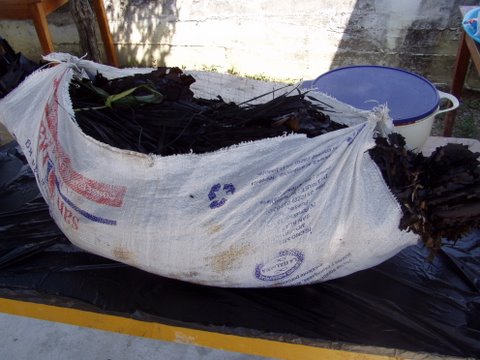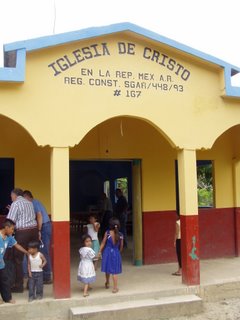Cristo, yaya catli tenextilía Toteco ya ipa itztoya quema ayamo oncayaya nochi catli onca. Cristo senitztoya ihuaya Toteco huan yaya Toteco. Yaya itztoya ihuaya Toteco ipan ipejya nochi catli onca. Cristo quichijchijqui nochi tlamantli, huan niyon se tlamantli catli onca amo yolqui iseli. Yaya nopa nemislismacaquetl huan quinmaca nemilistli nochi catli itztoque. Yaya nopa tlahuili catli quintlahuilía masehualme ipan ininyolo. Ni tlahuili tlahuía campa onca tzintlayohuilotl huan nopa tzintlayohuilotl amo hueli quisehuía.
(Juan 1:1-5)
At El Cañón, the first congregation we visited in the Huasteca, I noticed that even though most all the members knew Nahuatl, the singing was done in Spanish and there was a noted absence of a Nahuatl Bible. I inquired about this there, and as far as I could tell the Bible had not been translated into Nahuatl.
However, at Tlapexmecayo I discovered from the preacher there that a Bible did indeed exist in their native tongue—but it was translated by some denomination, and had doctrinal errors in it. At La Soledad brother Macario Zuniga showed me his Nahuatl Bible, and even brother Pascual owned one.
I was full of questions. If a Nahuatl Bible does exist, why don’t people use them? Are there truly errors in the text that could potentially deceive someone seeking the truth? At the house of brother Pascual (the man who recently started a congregation in his home), José Hernández Félix and brother Nicolás clarified it all for us.
Quite simply, no one reads or writes Nahuatl. Everyone who knows how to read and write does so in Spanish, because Nahuatl is a spoken language only. Granted, it is fairly easy to write the language using the Roman alphabet, but it is not taught in schools and practically no one can do it with ease.
Although some Aztecs have Bibles written in their own language, by far most of them read from the Reina-Valera version in Spanish. Perhaps this situation will change in the future, and only time will tell whether a new Nahuatl translation will be needed to aid the spreading of the Gospel.

 After visiting the congregation of the Lord’s church at
After visiting the congregation of the Lord’s church at